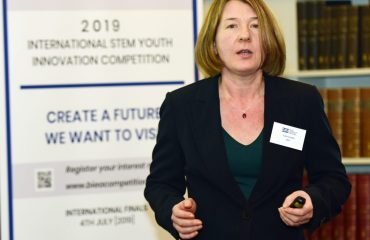With the finalist list announced the BIEA (2019) international youth science and innovation competition the atmosphere continues to intensify with the teams entering the final preparatory stage. The reports submitted in the preliminary contest not only reflect the understanding and cognition of each team of aspects of scientific innovation, but also represents the level that teenagers in different countries and regions have achieved. Being a leader in China’s economic development Shanghai has always attached great importance to science and innovation in education. The four teams sent by the second affiliated middle school of east China University in Shanghai are honoured to have reach the final to be held in London.
Students wholeheartedly embraced the project
The theme of BIEA (2019) international youth science and technology innovation competition is “drone wars and species extinction”. The combination of the popular UAV technology with humane animal protection projects has attracted active participation from schools from around the world. This includes the second affiliated middle school of East China in Shanghai. Due to the large number of students that have enrolled for the project the school selected two teams in the 12-14 age group from the Junior Middle School and one team in that age group and another aged 15-17 from the International Department to participate in the competition.

Although they love science and innovation, how to combine drones with animal protection was still a great challenge for the children. Teachers Yang Bing and Chen Giong asked experts from Shanghai Jiao Tong school of aeronautics and astronautics to give advice and help. The International Department and the Agricultural School in the University arranged for the children to visit the drone base of the university to experience examples of the uses of drone technology. This increased the enthusiasm and excitement amongst the children for the competition.

Brainpower and hardwork. UAV design fun
After discussion with teachers and comprehensive research children quickly chose the animals to be protected by their teams and modified the UAV designs according to the environment and habits of the animals selected.
The Typhoon group of students in the Junior Middle School chose the Chinese flying squirrel with multiple teeth as the animal to protect. Because of the nocturnal habits of the flying squirrels the students decided to use a wide-angle camera to observe and locate the caves they inhabit during the day and then use the night vision camera to observe and count the population at night. The advantages and disadvantages of all kinds of equipment were assessed and used to help them complete their objectives.

The UAV Cavalries team, another team from the middle of the primary school, selected the Asian elephant to help protect. They had to consider such things as counting the population, the encroachment of poachers and the availability of water. All of this was considered and researched in creating their project.
The junior high school and senior school teams of the International Department chose snow leopards and Chinese alligators as their animals to help protect. Each carried out comprehensive research on their respective animals and used their spare time to investigate design and construction characteristics of drone technology. The whole experience was very enjoyable.
The challenge was met and all four teams are finalists
The UAV design and modification process greatly facilitated the children’s creative thinking as well as their ability to research projects and develop the attendant skills. One of the many things that the students from the International Department’s 15-17 age group team discovered during their research on the Chinese alligator was that it’s skin colour was so close to that of the rocks on which it basked that it was difficult to see and that it was poikilothermic (cold blooded) and could not be tracked by an infrared camera.
To overcome this problem the team researched the habits of the alligators and discovered that they liked to float on the water and that their eyes glowed red when illuminated at night. This enabled the team to devise a method for counting the alligators with their drone.

During one of the flights to test the design of the drone near a school pond the sound startled a water bird catching fish and it’s wings knocked the drone. Fortunately, all was not lost and the children guided the drone to a save landing in a large stone in the middle of the pond. Yan Li, a science teacher and innovation instructor at the school was full of praise for the way the children handled the crisis.

The science and technology innovation competition is a perfect opportunity to exercise children’s science and technological innovation ideas and practical ability. The competition also allows the children to express their very human instincts in their desire to protect wild animals whilst displaying their innovative and technological skills to others from around the world and experts in STEM education. This can only bode well for the future.
When we found out that our team had been shortlisted for the finals and that we were going to London to participate we all cheered. We are full of pride and are honoured in the mission to compete with other school teams from around the world. I hope that the preparations for the finals that we are making at present will result in a most enjoyable time for all concerned and that Shanghai will prove a worthy competitor in the competition.


